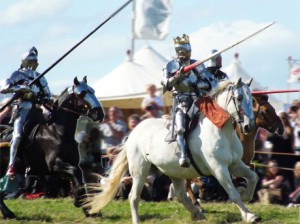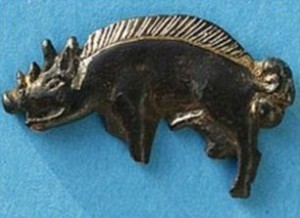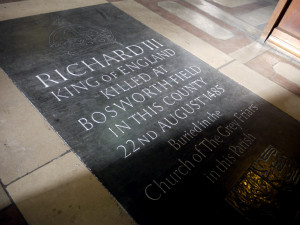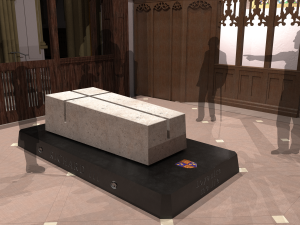22 August marks the anniversary of the Battle of Bosworth at which in 1485 the ruling king of England, Richard III, was killed. With Henry VII taking the throne it was the end of the Plantagenet era and the beginning of the reign of the Tudors. In 1548 Edward Hall described the scene in his book The Union of the Two Noble Families of Lancaster and York:
For when they which were next about his person saw and perceived at the first joining of the battle the soldiers faintly and nothing courageously to set on their enemies,… [they] determinedly advised him to save himself by flight: and when the loss of the battle was imminent and apparent, they brought to him a swift and a light horse to convey him away. He which was not ignorant of the grudge & ill will the common people bare toward him, casting away all hope of fortunate success & happy chance to come, answered (as men say) that on that day he would make an end of all battles or else there finish his life. Such a great audacity & such a stout stomach reigned in his body, for surely he knew it to be the day in the which it should be decided & determined whether he should peaceably obtain & enjoy his kingdom during his life, or else utterly forgo & be deprived of the same, with which too much hardiness he being overcome hastily closed his helmet, and entered fiercely in to the hard battle, to the intent to obtain that day a quiet reign & regiment or else to finish there his unquiet life.
Shakespeare’s fictionalised version is slightly different of course, but his Richard too fought bravely on the battle field before being savagely killed. Even without the distortions that were later introduced, which Shakespeare repeated, the details of the battle and the death of Richard have long been disputed. For more information about Richard III take a look at Matthew Lewis’s blog post written in 2013.
In the last few years a series of events have provided us with much more information. In 2010 archaeologists discovered weapons, armour and cannon balls in a field about a mile away from the assumed site of the battle. It was confirmed as the correct site when a silver badge in the shape of Richard’s emblem, the boar, was discovered. The brooch would have been worn by one of Richard’s knights who fought with him and may well have died with him. This article goes into more detail. The existing Bosworth Battlefield heritage centre remains where it was, and visitors walk the mile to the actual site.
Then came the dig in Leicester in 2012 which, almost unbelievably, discovered a skeleton under a car park, followed in February 2013 by evidence that showed beyond reasonable doubt that the remains were those of Richard III. Then the “Plantagenet Alliance” challenged the agreed site in which Richard was to be buried, suggesting this should be in York rather than Leicester. This was eventually over-ruled and the reburial will now take place in Leicester Cathedral on 26 March 2015 following several days of events in Leicestershire.
The remains, currently at the University of Leicester where the research has been carried out, will be put in a lead-lined coffin and taken by hearse to Bosworth where events to mark the king’s last day will be carried out. A service will then take place at Bosworth and the coffin will be taken to Leicester cathedral where it will lie for three days so that members of the public can pay their respects before the actual reinterment. They are anticipating a great deal of interest in this “fitting, dignified and memorable ceremony” which will be strictly by invitation only, and broadcast live on Channel 4. The Visitors Centre in Leicester is now open and the City of Leicester has already devised a number of Richard III-themed walks and events. The University of Leicester has been central to the discovery and recently ran its FutureLearn MOOC (free online course), England in the Time of Richard III. It has now finished but it’s to be hoped that it will be repeated in early 2015 given the intense interest in the subject. If you want to find out more, the link above includes a trailer for the course. My husband has just completed the course and greatly enjoyed it: a visit to Leicester and Bosworth is now a priority. Shakespeare may have got some of the details wrong, but the interest in Richard III in the twenty-first century is at least partly the result of the brilliance of Shakespeare’s Richard, one of the most compelling dramatic characters ever created.





